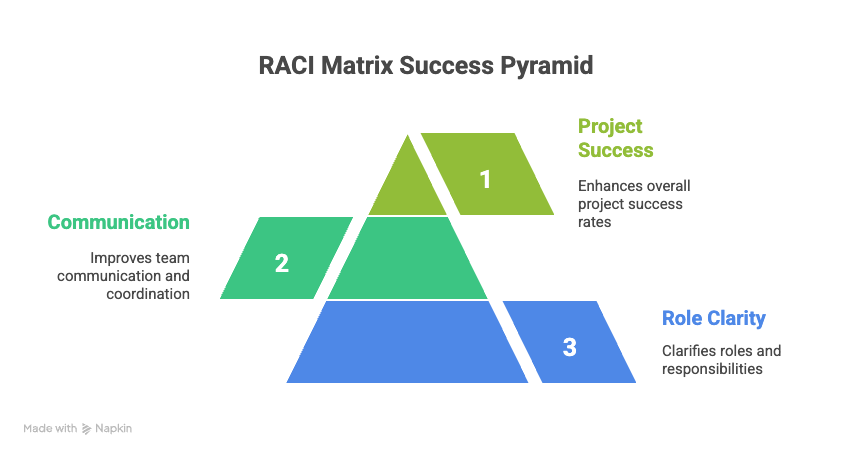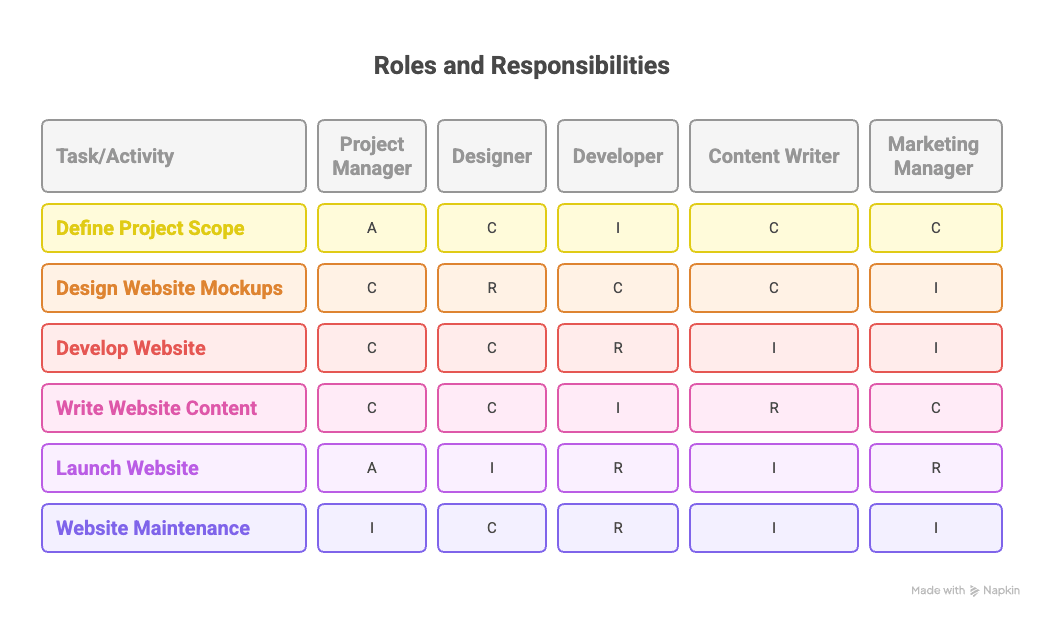Agile Certifications, AI and PM, PDUs
RACI Matrix: A Comprehensive Guide
RACI Matrix: A Comprehensive Guide
This document provides a comprehensive overview of the RACI matrix, a powerful tool for clarifying roles and responsibilities in projects and processes. It explains the meaning of each RACI role (Responsible, Accountable, Consulted, and Informed), outlines the benefits of using a RACI matrix, and provides practical guidance on how to create and implement one effectively. By understanding and utilizing the RACI matrix, teams can improve communication, reduce confusion, and enhance overall project success.
What is a RACI Matrix?
A RACI matrix, also known as a responsibility assignment matrix, is a visual tool used to clarify roles and responsibilities for tasks or activities within a project or process. It helps to ensure that everyone involved understands their specific duties and who they need to interact with to complete the work effectively. The acronym RACI stands for:
-
Responsible: The person or people who do the work to complete the task. They are responsible for execution.
-
Accountable: The person who is ultimately answerable for the correct and thorough completion of the task. Only one person can be accountable for each task.
-
Consulted: The people who need to be consulted before a decision or action is taken. They provide input and expertise.
-
Informed: The people who need to be kept informed of progress or decisions. They receive updates but don’t actively participate in the task.

Why Use a RACI Matrix?
Using a RACI matrix offers several benefits, including:
-
Clarity of Roles and Responsibilities: It eliminates ambiguity about who is responsible for what, reducing confusion and overlap.
-
Improved Communication: It facilitates clear communication channels by identifying who needs to be consulted or informed.
-
Increased Accountability: It ensures that someone is ultimately accountable for each task, promoting ownership and responsibility.
-
Reduced Conflict: By defining roles upfront, it minimizes potential conflicts arising from unclear expectations.
-
Enhanced Efficiency: It streamlines workflows by ensuring that the right people are involved at the right time.
-
Better Resource Allocation: It helps to identify potential bottlenecks or resource constraints.
-
Improved Project Management: It contributes to better project planning, execution, and control.
-
Onboarding New Team Members: It provides a quick and easy way to understand the roles and responsibilities within a project or process.
Creating a RACI Matrix: A Step-by-Step Guide
Creating a RACI matrix involves the following steps:
-
Identify Tasks/Activities: List all the tasks or activities required to complete the project or process. These should be specific and actionable.
-
Identify Roles/Stakeholders: List all the roles or stakeholders involved in the project or process. This includes individuals, teams, or departments.
-
Assign RACI Roles: For each task/activity, assign the appropriate RACI role to each role/stakeholder. Use the following guidelines:
* **Responsible:** Who is doing the work? There can be multiple people responsible for a task.* **Accountable:** Who is ultimately responsible for the task's completion? There should be only one person accountable.* **Consulted:** Who needs to provide input or feedback before the task is completed?* **Informed:** Who needs to be kept updated on the task's progress?-
Review and Validate: Review the matrix with all stakeholders to ensure that it accurately reflects their understanding of roles and responsibilities.
-
Communicate and Implement: Communicate the finalized RACI matrix to all stakeholders and ensure that they understand their assigned roles.
-
Update and Maintain: Regularly review and update the RACI matrix as needed to reflect changes in the project or process.
Example of a RACI Matrix
Here’s a simple example of a RACI matrix for a website redesign project:
| Task/Activity | Project Manager | Designer | Developer | Content Writer | Marketing Manager |
| ———————– | ————— | ——– | ——— | ————– | —————– |
| Define Project Scope | A | C | I | C | C |
| Design Website Mockups | C | R | C | C | I |
| Develop Website | C | C | R | I | I |
| Write Website Content | C | C | I | R | C |
| Launch Website | A | I | R | I | R |
| Website Maintenance | I | C | R | I | I |

Key:
-
R: Responsible
-
A: Accountable
-
C: Consulted
-
I: Informed
Best Practices for Using a RACI Matrix
-
Keep it Simple: Avoid overcomplicating the matrix with too many tasks or roles.
-
Focus on Key Activities: Prioritize the most important tasks and activities.
-
Involve Stakeholders: Engage stakeholders in the creation and review of the matrix.
-
Ensure Accountability: Make sure that each task has a single accountable person.
-
Communicate Clearly: Clearly communicate the RACI matrix to all stakeholders.
-
Regularly Review and Update: Keep the matrix up-to-date to reflect changes in the project or process.
-
Use it as a Communication Tool: Use the matrix to facilitate communication and collaboration.
-
Don’t Overuse It: Use the RACI matrix strategically for projects or processes where clarity of roles is critical.
Common Mistakes to Avoid
-
Multiple Accountable Parties: Having more than one person accountable for a task can lead to confusion and lack of ownership.
-
Ignoring the “Consulted” Role: Failing to consult with relevant stakeholders can result in poor decisions and rework.
-
Over-Informing: Informing too many people can lead to information overload and decreased efficiency.
-
Creating the Matrix in Isolation: Developing the matrix without input from stakeholders can result in inaccuracies and resistance.
-
Treating it as a One-Time Exercise: Failing to regularly review and update the matrix can render it obsolete.
Conclusion
The RACI matrix is a valuable tool for clarifying roles and responsibilities, improving communication, and enhancing project success. By following the steps outlined in this document and adhering to best practices, teams can effectively utilize the RACI matrix to streamline workflows, reduce confusion, and achieve their goals. Remember to keep the matrix simple, involve stakeholders, and regularly review and update it to ensure its continued relevance and effectiveness.

